Peculiarities of the Audio System
High-end audio has been developed
for decades, and there are many products that are highly praised by audio enthusiasts. Some products are hard to find today.
Why do audio equipment companies no longer continue to produce these excellent products today?
Function Quality
Low-frequency analog circuits are fundamental circuits in electronic technology. The analog circuit that works
in the sound frequency band is also almost the lowest speed circuit. From a technical point of view, low-speed equipment should
be the easiest to achieve the intended function of the design. Therefore, people can find many audio equipment with excellent
technical indicators in the audio market. However, as a music player, the sound quality of these equipments still differs
greatly. Among them, the accuracy of emotion expression is the most significant. If we compare the live sound, we can find
that the current audio sound still has some mechanical relatively rigid. Although, feelings vary from person to person, and
technically we still have no way to measure emotions. However, people can still easily distinguish the emotional difference
between the two sounds based on experience and memory.
In terms of function, the audio system has reached the function
it should have as a commodity. As consumer electronics products, audio equipment also has outstanding performance in the market.
If we say that audio equipment has not played a perfect role in music playback, it is only because their functions still have
some quality problems.
To explore functional quality issues, we need to understand the particularity of the audio system.
Wide bandwidth : The audio equipment works in the 20Hz-20KHz frequency band. The frequency bandwidth
is approximately equal to 10 octave bands (20Hz x 2^10 = 20,480Hz). For equipment design, the analog circuit uses octave as
a unit to calculate the bandwidth to standardize the working range and effectiveness. So far, among the electronic equipments
used by human beings, apart from the audio system, there is no equipment that needs to work effectively in such a wide frequency
band.
Real-time: The frequency components in the sound spectrum are consistent in time. If we regard
the human ear as a sensor, then it is an absolute real-time sensor. The audio system provides services for the sensor, and
inadvertently agrees that it needs to meet the real-time requirements of the sensor.
Sine wave signal
Usually, we use sine waves to measure audio equipment. A sine wave signal without distortion has only one frequency component
on the spectrogram. In the waveform diagram, the sine wave does not need to be superimposed with other frequency components
to form a complete waveform. Therefore, there will be no time difference between various frequency components. Regardless
the sine's frequency or the equipment's working bandwidth, the above conditions are the same. In other words, a single sine
wave signal will not have real-time problems in equipments with various operating bandwidths.
However, the music signal
is different.
Music Signal
From the oscilloscope, we can see that when music information is
converted into electrical signals, it is a series of non-periodic signals. Through Fourier transform spectrum analysis, we
can know that the non-periodic signal spectrum is a continuous spectrum. This means that the music signal spectrum contains
an infinite number of frequency components. To maintain a complete signal (without distortion), it is necessary to maintain
a complete signal spectrum. The completeness mentioned here includes the amplitude and time consistency of each frequency
component.
Real-time possibilities
As a music playback tool, audio equipment needs to process
music electrical signals in real time. Under the current conditions, can it have this ability? If we examine this question
in terms of components, technology, and market, the answer seems to be yes. The reasons are as follows,
-
Components.
The electronics industry has been able to produce very high frequency consumer products at the GHz level. Therefore, for low-frequency
equipment in the audio category, we can always find suitable components. These include technical characteristics that can
meet working speed and response time.
-
Technical aspects. There are many laws in electronic technology that
have been repeatedly demonstrated as correct. If the equipment design is regulated by these laws, we can conclude that the
equipment can achieve the expected function. Various functional equipment have been successfully applied to various industries,
which is enough to prove that the current functional design methods have extremely high accuracy, and low-speed equipments
should be more like this. Moreover, high-end audio has gone through decades and has accumulated rich experience for high-quality
equipment design.
The market. From a variety of high-end materials used in audio equipment, we can see that
high-quality equipment is pursued and accepted in the audio market. Yes, in order to meet the needs of the market, the production
of high-end audio products almost does everything possible to take any measures to ensure that the expected functions of the
equipment are realized.
The phenomenon of real-time
For audio equipment that works
in the frequency band below 20 KHz, it is difficult for us to find the factors that hinder real-time performance in the above-mentioned
aspects. However, in actual use, we do not see the expected phenomenon in line with the real-time spectrum: accurate playback
of the original recorded live sound. In principle, music playback equipment should be able to have this function. In fact,
high-end audio has been sought after in the past few decades, which shows that the market is also pursuing this function.
Explore
If we believe that the audio system has the functions, it should be able to accurately replay
the original recorded live sound, and the current equipment cannot achieve this effect. So, what are the factors that hinder
the audio equipment, causing it to fail to achieve the full-function's quality? Next, we want to find the answer to this question.
This answer should be able to reasonably explain the many phenomena that appear in the audio system, and it is applicable
to all electronic equipments.
First, we need to build an analysis model for the electronic equipment.
When
we open an equipment's shell to look at its internal structure, we can see that various electronic components are distributed
inside the equipment. Each component is responsible for signal processing. Circuit wiring connects these components and plays
a role in transmitting signals. There, it is easy for us to have the illusion that signal transmission only appears in circuit
wiring. However, when we understand the internal structure of the component, we can know that signal processing only occurs
at a certain point on the physical structure of the component, and the physical space beyond this point is only responsible
for signal transmission. With this recognition, we can use such a perspective to understand electronic equipment: In electronic
equipment, signal transmission occupies most of the physical space.
Based on this knowledge, we can equate electronic
equipment with such an analysis model:
Electronic equipment are a collection of
transmission lines and signal processing points.
The signal processing point, to be precise, it is a segment.
Different components have different segment lengths As long as it is a segment, it necessarily contains transmission line
characteristics. For this signal processing point, its proportion of transmission line characteristics will increase with
the segment's length.
Agreement
Circuit design is to construct the most appropriate circuit according
to the needs of the equipment function, and by selecting the appropriate component parameter values, so that the circuit can
work in a state that is most conducive to the equipment function.
Analysis
The signal processing
point is the working point of the component. When designing the circuit, the component parameter values have been calculated
to the most suitable value according to the needs of the equipment. When the equipment is working, if the component parameter
value is equal to the design value, we can assume the quality of the signal processing point as the full-function quality.
This assumption is based on the components, technology and market guarantees mentioned above. When all signal processing points
meet this assumption, we can exclude the influence of signal processing points in the functional quality analysis. So far,
in the equipment equivalent analysis model, the only elements that can affect the functional quality are the transmission
lines.
Verification
The above inference can be verified on a audio system with high analytical
capabilities: if the audio system uses different cables, we can hear sounds with different emotional states. This means that
different cables have different functional qualities.
Cause
Cables are called transmission lines
in electronics, and they also belong to electronic circuits. The transmission line circuit contains various distributed components.
Distributed components are different from physical components, and their parameter values have uncertainty and wide-range
dispersion due to various factors. However, these parameters control various characteristics of the transmission line circuit.
When the transmission characteristics have different restrictions on different frequency signals, it will affect the broadband
signal transmission. Different amplitude constraints produce uneven frequency response characteristics; different time constraints
will lead to inconsistent time for each frequency component on the signal spectrum to reach the terminal. These different
constraints destroy the integrity of the real-time spectrum, leading to micro-dynamic distortion of the signal. Different
levels and different constraints, their various combinations, are specifically embodied as different cables will have their
own different emotional state sounds.
For electronic equipment, the circuit design determines the function, but the
function's quality is affected by the transmission's quality . Below, we will analyze the transmission quality in more detail.
Distribution Parameters
Transmission lines are not limited to cables. Any wire used to transmit signals
belongs to the category of transmission lines. There are some theories about transmission lines in electronic technology.
People use these theories to design cables for various purposes. Here, we only focus on the important element that affects
the quality of transmission: distribution parameters (parameters of distributed components). Distributed components are not
physical components that we usually see and touch. It is a segment of wire with its own resistance and inductance. And this
wire is coupled with other wires in the space in which it is located, and thus has the characteristic that there is almost
a physical component, so we equate it as a component. All of these we call it a distributed element. Its parameters are called
distribution parameters.
Transmission Line Circuitry
A wire can be divided into infinite number
of segments. For double wires, each wire segment can be equivalent to multiple distributed elements with different characteristics.
These distributed components form a four-terminal network Transmission line circuit. The distribution parameters control the amplitude-frequency, delay and other characteristics of this network. If the network
circuit is a physical component, then, by selecting appropriate component parameter values, we can control the network characteristics
to match the equipment function. But the distributed components are different.
Uncertainty
Distribution
parameters are an annoying problem. In electronic equipment, distributed components are everywhere. The parameter values are
affected by many factors and cannot be accurately predicted. The components, circuit boards and leads for different production
batches, the parameter values reflected by the distributed components will be different when they in working. Therefore, if
electronic equipments are produced in different batches, there will be some differences in their functional quality. In addition,
for components produced in the same batch, there are still wide-ranging differences (discreteness) in parameter values between
components. Therefore, there will still be slight quality differences between equipments produced in the same batch of components..
When we understand the various technological processes in component production, we can know that this situation is inevitable
and cannot be changed.
Unique
The particularity of the audio system is the real-time signal processing
in a wide-band environment. This requires the transmission line circuit to have the same delay time for each frequency component
on the signal spectrum. Only this unique delay characteristic (the same delay time) can satisfy the audio system. When the
combined parameter values are uncertain and discrete, the chance that the transmission line circuit can achieve this unique
delay characteristic is equivalent to finding a predetermined value from a random number. The frequency bandwidth is also
equal to the number of digits in the predetermined value. As the number of bits increases, the chance that this given value
can be obtained from a random number will approach infinitesimal.
Results
The distribution parameters
are uncertain, and the transmission characteristics will vary with the parameters. The signal transmitted on the transmission
line will be restricted by the transmission characteristics. In addition to the amplitude difference between the frequency
components, there will also be some differences in the transfer time between the frequency components. This time difference
will increase with the frequency difference. For music electrical signals with a bandwidth equal to 10 octave, this time difference
has a serious impact on the real-time performance of the spectrum.
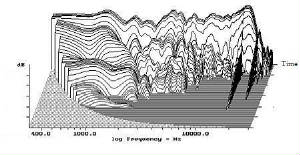 Phenomenon
Phenomenon
We can understand this effect from the daily music playing.
When music information
is converted into electrical signals: every specific time period, there is always a corresponding frequency spectrum. Each
spectrum is assembled on the time axis to form a complete music.
For music played by a single musical instrument,
the frequency spectrum in each specific period is relatively narrow, and the frequency components in the frequency spectrum
are close to each other. Because similar frequencies always have similar delay times, it is easier to agree on the transfer
time. Especially for musical instruments with relatively few overtone components and relatively short duration, their sounds
are easier to achieve true reproduction in the audio system, such as xylophone.
-
Among various musical instruments,
the piano sound contains richer overtones, and these overtones also have larger amplitudes and longer durations. The overtone
of the previous note overlaps with the next note, creating a magnificent piano sound. This multi-level overlap makes the width
of the spectrum in each specific time period wider. Because the greater the frequency difference, the greater the difference
in delivery time. Therefore, the transmission of each frequency component in the spectrum is more difficult to achieve time
consistency. Compared with other musical instruments, it will be relatively more difficult for the audio system to reproduce
the real piano sound.
-
For classical music played by large orchestras, the entire audio frequency range from
low to high in each specific period of time is full of various frequency components. At this time, the difference between
high and low frequencies will reach the maximum. In the signal transmission process, the real-time nature of the frequency
spectrum is more likely to be destroyed. The result is that music playback will have stronger background noise*, and the sound
will be noisier and more chaotic.
* The sound that shouldn't be there is noise. The energy that shouldn't
be present at a certain point in time is the energy to generate noise.
Micro Dynamic Distortion
Music
information involves both the time domain and the frequency domain. The frequency and amplitude of music sounds will change over time. The time-frequency information is converted into electrical
signals in a time-sequentially distributed magnitude.
Audio equipment transmits and processes music electrical signal. In this process, if the delay time of some frequency components is inconsistent, the transmission time will be different
compared with others. Their arrangement position on the timeline will be wrong. This leads to: 1) The trajectory of voltage
magnitude changes over time is broken due to changes in signal frequency. 2) The energy of some frequency components in the
wrong position will be superimposed with the energy of the new position. 3) Each frequency component arranged on the time
axis will produce a group drift with frequency as a parameter. The above situation will change the shape of the trajectory
of the voltage magnitude over time (micro-dynamic distortion), and it will be reflected in the change of timbre and emotional
state.
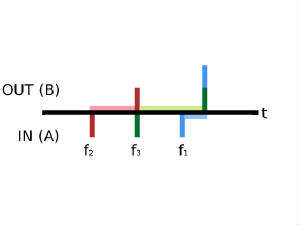 Diagram
Diagram
Three frequency components f1, f2, and f3 are set. They have different delay times on a certain
transmission line, and they are 1T, 2T, and 3T respectively (T is the time unit). The three frequency components are respectively
transmitted from end A to end B of the transmission line at 2T intervals. The transmission sequence is: f2, f3, f1. The position
changes of the three frequency components on the time axis before and after transmission are shown in the figure.
Fracture:
After the signal is transmitted to the B terminal, there is a 1T time interval break between f2 and f3. This break will be
filled by the integral effect of the circuit and manifested as a change in timbre and emotional state.
Superimposition:
The energy of f1 is superimposed on the energy of f3. Similarly, this superposition will also be reflected in changes in timbre
and emotional state.
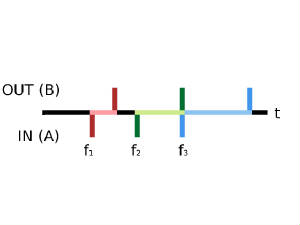
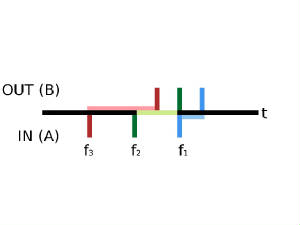 Group Drift: Generally, if signals of different frequencies have different delay times on the transmission line, the
delay time is positively correlated with the signal frequency. Combining the above figure, we can deduce that: in a piece
of music melody, a blue shift (Doppler effect) will occur during the transition period of Pitch from high to low. And, during the transition period of Pitch from low to high, a red shift will occur. That is, during
music playback, the duration of each note remains unchanged, while the transition duration between two notes will be compressed
or expanded with the change of pitch. This effect causes individual notes (groups with frequency as a parameter) in a melody
to drift on the time axis. Specifically, it will be reflected in changing the timbre of the voice and emotional state.
Group Drift: Generally, if signals of different frequencies have different delay times on the transmission line, the
delay time is positively correlated with the signal frequency. Combining the above figure, we can deduce that: in a piece
of music melody, a blue shift (Doppler effect) will occur during the transition period of Pitch from high to low. And, during the transition period of Pitch from low to high, a red shift will occur. That is, during
music playback, the duration of each note remains unchanged, while the transition duration between two notes will be compressed
or expanded with the change of pitch. This effect causes individual notes (groups with frequency as a parameter) in a melody
to drift on the time axis. Specifically, it will be reflected in changing the timbre of the voice and emotional state.
Summary
The formation mechanism and influence of distributed components are the same for all types
of electronic equipments. A cable (transmission line circuit) with distributed components as the main component is just a
special case. The existence of distributed components is a natural phenomenon and not an error. It has such a serious impact
on the functional quality of audio equipment, which lies in the uncertainty and discreteness of its parameter values, as well
as the particularity of the audio system itself. The coincidence of several factors has created the various forms of sound
of the audio equipment. In the environment of their respective expressions, music lovers choose their favorites. Those products
that have been admired by everyone have become yesterday's classics pursued today.
If the functional quality of audio
equipment needs to go further, effective control of the distributed parameters is necessary. This is also the necessary means
to solve the problem of the consistency of equipment functional quality.
Created by Chen
Date of renovation:Aug-2012
Last revision date: Aug-2021
The components
completed distributed parameter controls.
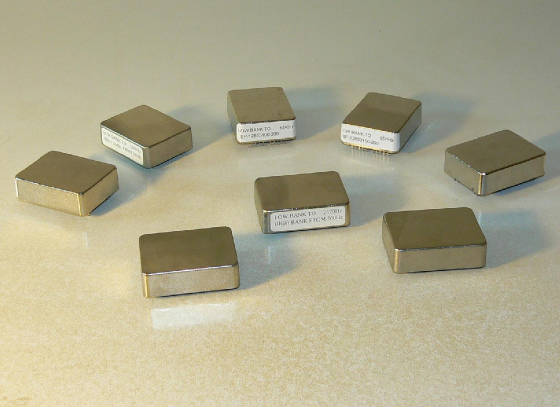
A number of WRT Cable completed distributed parameter control。
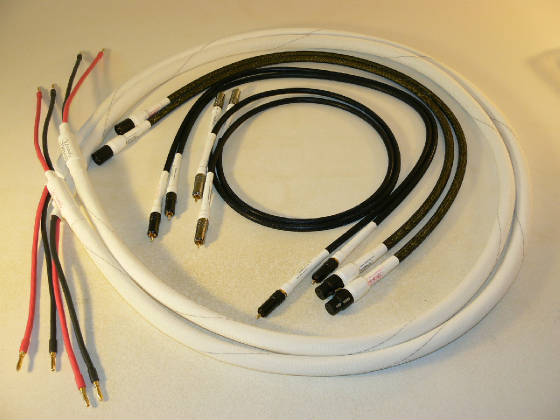


 Phenomenon
Phenomenon Diagram
Diagram
 Group Drift: Generally, if signals of different frequencies have different delay times on the transmission line, the
delay time is positively correlated with the signal frequency. Combining the above figure, we can deduce that: in a piece
of music melody, a blue shift (Doppler effect) will occur during the transition period of
Group Drift: Generally, if signals of different frequencies have different delay times on the transmission line, the
delay time is positively correlated with the signal frequency. Combining the above figure, we can deduce that: in a piece
of music melody, a blue shift (Doppler effect) will occur during the transition period of